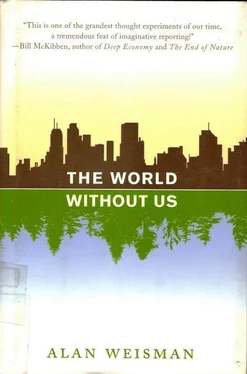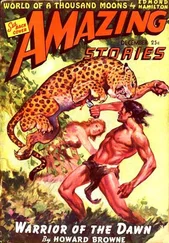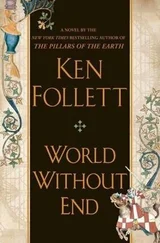Recorded history from civilization’s Fertile Crescent beginnings to the present day has taken barely more than 1/ 100th of the time that our ancestors lived in this one spot, grubbing plants and heaving sharpened stones at animals. There must have been a lot of prey to feed a growing predator population with awakening technological skill. Olorgesailie is cluttered with femurs and tibia, many smashed for their marrow. The quantities of stone tools surrounding the impressive remains of an elephant, a hippo, and an entire flock of baboons, suggest that the entire hominid community teamed up to kill, dismember, and devour their quarry.
Yet how is this possible if in less than a millennium human beings decimated America’s supposedly richer Pleistocene megafauna? Surely Africa had even more people, and for a lot longer. If so, why does Africa still have its famous big-game menagerie? The flaked basalt, obsidian, and quartzite blades at Olorgesailie show that for a million years hominids could cut even an elephant’s or a rhino’s thick hide. Why aren’t Africa’s big mammals extinct as well?
Because here, humans and megafauna evolved together. Unlike the unsuspecting American, Australian, Polynesian, and Caribbean herbivores who had no inkling of how dangerous we were when we unexpectedly arrived, African animals had the chance to adjust as our presence increased. Animals growing up with predators learn to be wary of them, and they evolve ways to elude them. With so many hungry neighbors, African fauna have learned that massing in large flocks makes it harder for predators to isolate and catch a single animal, and assures that some are available to scout for danger while others feed. A zebra’s stripes help it befuddle lions by getting lost in a crowded optical illusion. Zebras, wildebeest, and ostriches have forged a triple alliance on open savannas to combine the excellent ears of the first, the acute sense of smell of the second, and the sharp eyes of the third.
If these defenses worked every time, of course, the predators would go extinct. An equilibrium emerges: in a short sprint, the cheetah gets the gazelle; in a longer race, gazelles outlast the cheetah. The trick is to avoid becoming someone else’s dinner long enough to breed replacements, or to breed often enough to insure that some replacements always survive. As a result, carnivores like lions often end up harvesting the sickest, oldest, and weakest. That was what early humans did as well—or, like hyenas, at first we probably did something even easier: we ate the carrion left by some more adept hunter.
Equilibrium dissolves, however, when something changes. The genus Homo ’s burgeoning brain spawned inventions that challenged herbivore defense strategies: tight flocks, for example, increased the odds that a thrown hand-axe would actually connect with a target. Many species found in Olorgesailie sediments, in fact, are now extinct, including a horned giraffe, a giant baboon, an elephant with down-curved tusks, and a hippopotamus even beefier than today’s. It isn’t clear, however, that humans drove them to extinction.
This, after all, was the mid-Pleistocene—a time when 17 ice ages and their interregna yanked global temperatures up and down and alternately soaked or parched any land that wasn’t frozen solid. The Earth’s crust squeezed and relaxed under the shifting weight of ice. The Eastern African Rift widened and volcanoes blew, including one that periodically bombed Olorgesailie with ashes. After two decades of studying Olorgesailie’s strata, Smithsonian archaeologist Rick Potts began to notice that certain persistent species of plants and animals typically survived periods of climatic and geologic upheaval.
One of these was us. At Lake Turkana, a Rift lake shared by Kenya and Ethiopia, Potts tallied a rich trove of our ancestors’ remains and realized that whenever climate and environmental conditions grew unruly, early species of Homo outnumbered, and finally displaced, even earlier hominids. Adaptability is the key to who is fittest, one species’ extinction being another’s evolution. In Africa, megafauna fortunately evolved their own adaptable forms right along with us.
That is fortunate for us, too, because to picture how the world was before us—as our basis for understanding how the world may evolve after us—Africa is our most complete bank of living genetic heritage, filled with entire families and orders of animals that were sacked elsewhere. Some actually are from elsewhere: when North Americans stand in the open sunroof of a safari jeep in the Serengeti, stunned by the vastness of a herd of zebras, they’re seeing descendants of American species that herd over Asian and Greenland-European land bridges, but are now lost to their own continent. (That is, until Columbus reintroduced Equus after a hiatus of 12,500 years; before that, some horse species that flourished in America were probably also striped.)
If Africa’s animals evolved learning to avoid human predators, how would the balance swing with humans gone? Are any of its megafauna so adapted to us that some subtle dependence or even symbiosis would be lost along with the human race, in a world without us?
The high, cold Aberdares moors in central Kenya have discouraged human settlers, though people must have always made pilgrimages to this source. Four rivers are born here, heading in four directions to water Africa below, plunging along the way from basalt overhangs into deep ravines. One of these waterfalls, the Gura, arcs through nearly 1,000 feet of mountain air before being swallowed by mist and tree-sized ferns.
In a land of megafauna, this is an alpine moor of megaflora. Except for a few pockets of rosewood, it is above the tree line, occupying a long saddle between two 13,000-foot peaks that form part of the Rift Valley’s eastern wall, just below the equator. Treeless—yet giant heather rises 60 feet here, dripping curtains of lichen. Groundcover lobelia turns into columns eight feet high, and even groundsel, usually just a weed, mutates into 30-foot trunks with cabbage tops, growing amid massive grass tussocks.
Small wonder that the descendants of early Homo who climbed out of the Rift and eventually became Kenya’s highland Kikuyu tribe figured that this was where Ngai—God—lived. Beyond the wind in the sedges and the tweep of wagtails, it’s sacredly quiet. Rills lined with yellow asters flow soundlessly across spongy, hummocked meadows, so rain-logged that streams appear to float. Eland—Africa’s biggest antelopes, seven feet tall and 1,500 pounds, their helix horns a yard long, their numbers dwindling—seek refuge at these freezing heights. The moor is too high for most game, though, except for waterbucks and hidden lions who await them in fern forests along the plunge pools.
At times elephants appear, babies following a big tusker as she stomps through purple clover and smashes giant thickets of St. John’s wort in pursuit of her daily 400 pounds of forage. Fifty miles east of Aberdares, across a flat valley, elephants have been spotted near the snow line of Mount Kenya’s 17,000-foot spire. Far more adaptable than their late woolly mammoth cousins, individual African elephants once could be tracked by trails of dung leading from Mount Kenya or the cold Aberdares down to Kenya’s Samburo desert, an elevation drop of two miles. Today, the din of humanity interrupts the corridors linking those three habitats. The elephant populations of Aberdares, Mount Kenya, and Samburo have not seen each other for decades.
Below the moor, a 1,000-foot band of bamboo circles the Aberdares Mountains, sanctuary to the nearly extinct bongo, another of Africa’s striped camouflagees. In bamboo so dense it discourages hyenas and even pythons, the spiral-horned bongo’s only predator is unique to the Aberdares: the seldom-seen melanistic, or black, leopard. The brooding Aberdares rain forest is also home to a black serval and a black race of the African golden cat.
Читать дальше











